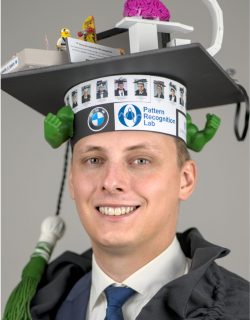Alexander Preuhs
Model-Based and Data-Driven Geometry Alignment for Angiography Systems
Tomography is the reconstruction of internal structures based on a sensory signal. X-ray cone-beam computed tomography (CBCT) measures the X-ray absorption with a source-detector gantry mounted on a C-shaped arm that rotates around the object. During the rotation, projection images are acquired. To obtain a tomographic reconstruction, the projection data is filtered and back-projected using the geometry information from the scan trajectory. This technique is of high relevance for stroke applications, where a hemorrhagic stroke is to be distinguished from an ischemic stroke. By performing the stroke diagnostic on the interventional CBCT system, no patient transfer is required which minimizes the door-to-groin time. However, due to the prolonged acquisition time of CBCT compared to diagnostic computed tomography (CT), the likelihood of patient motion increases. This provides the demand for rigid motion compensation and geometry alignment algorithms. In this thesis, we investigate model-based and data-driven approaches for the compensation of geometry misalignment.
Grangeat’s theorem provides a measure to compare the geometric consistency of two projections. In an ideal scenario, the derivative of corresponding epipolar line integrals is equal. Geometric inaccuracies and motion lead to unmatched epipolar line pairs and impair a corresponding consistency measure. We present algorithmic extensions for the computation of Grangeat’s consistency based on a pair of projection images. Using these extensions, we derive analytic motion gradients describing the change of consistency with respect to a rigid motion. Grangeat’s theorem is known to be eÿcient for out-plane motion compensation within circular trajectories, however, in-plane motion is barely detectable. We devise the X-trajectory which is sensitive to both, in-plane and out-plane motion. The X-trajectory can be computed from a regular short-scan, if the object is symmetric, by mirroring the trajectory at the symmetry plane. This requires the estimation of the object’s symmetry plane. We show that Grangeat’s theorem is suitable for the estimation of symmetry planes using an anthropomorphic head phantom. With experiments using digital phantoms and real acquisitions, we show that the X-trajectory improves in-plane motion com-pensation. Hence, symmetry is a powerful concept with encouraging initial results when applied to head imaging, which is worth further investigations to validate its clinical applicability.
We also investigate data-driven approaches, where we learn a cost function di-rectly from the clinical data. In this context, we use an appearance learning ap-proach, where a network is applied to regress the reprojection error (RPE) from the reconstructed slice images. The RPE is available during training of the network, be-cause the ground-truth geometry as well as the motion-affected geometry are known. The RPE measures the reconstruction-relevant deviations and is convex. We devise a siamese triplet network to regress the mean reprojection error (mRPE) as well as a projectionwise RPE. The latter provides a rough estimate which parts of the trajec-tory are affected by motion, whereas the mRPE is used as optimization target. The motion compensated geometry is found by a constraint optimization of the mRPE, where only projections are optimized that are classified by the network as motion-corrupted. Using a motion compensation benchmark we show that our approach is superior compared to state-of-the-art image quality metrics (IQMs).
